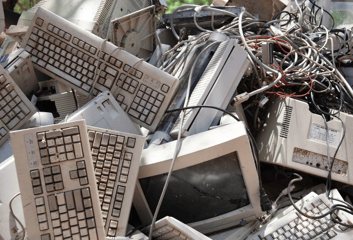Top 3 Ways to Reduce Your E-Waste
Despite the many positive impacts technology has had on society, there are growing environmental concerns around the number of devices at our disposal. Our demand and reliance on electronics is creating the fastest growing stream of waste in the world.
What exactly is E-Waste?
“E-Waste” is a term used to describe used electronics that are nearing the end of their useful life, and are discarded, donated or recycled. With more devices on the market year after year, the amount of electronic waste is exploding. 
The United Nations is calling it the Tsunami of E-Waste and has projected that more than 52 million metric tons will end up in landfills around the world. That’s the equivalent weight of more than nine Pyramids of Giza or more than 125,000 jumbo jets, which is more jumbo jets than we’ve created since the beginning of aviation.
The World Bank estimates that global waste will grow by 70% by 2050 (compared to 2016) as nations and cities urbanize, develop economically, and grow in terms of population.
Global smartphone adoption is estimated to have reached 80% in 2021 compared to 49% in 2016. That equates to 6.57 billion smartphone users. What happens when the phones reach their end of life? According to the UN’s e-waste monitor, less than 18% of e-waste is collected or properly processed.
What takes 190,000 liters of water, 1,200 kgs of natural resources and 20+ elements from the periodic table (resulting in 331kgs of carbon emissions)?
That’s what is required to manufacture a laptop, something that we use for a handful of years and then historically threw in the trash.
Here are three key trends that can prioritize your efforts to reduce e-waste.
1. Embrace The Circular Economy
The best way to overcome these obstacles is to transition away from the traditional linear economy and move to the circular economy. In the linear economy, we take from the ground, make something, use it and then throw it back in the ground. The circular economy is a closed-loop concept that eliminates waste.
To start, we need firm policies ensuring that manufacturers are using recycled content and are considering durability, reuse and safe end-of-recycling in their design. Any reusable waste should be put back into the manufacturing phase.
More and more OEMs are championing this concept. HP, a proven leader in sustainability, has created the Dragonfly, the first notebook that has post-recycled plastics built into the device. Microsoft just released an ocean plastic mouse in which 20% of the shell is made with recycled ocean plastic.
From a use standpoint, we need to look for devices that have a smaller carbon footprint and high energy efficiency. We must consider sustainable IT models, such as Device-as-a-Service or Product-as-a Service or any model that ensures a second life. These vehicles promote better sustainability practices by providing a tighter control of asset management and pre-determined lifecycle management.
The biggest impact that we can make is in the life-extension stage, which can be done through repair or working with reputable IT asset disposition organizations.
2. Adopt Green ProcurementGreen IT procurement prioritizes goods and services with a reduced environmental impact. More and more companies are adopting green procurement for their lines of business.
We need to evaluate our suppliers on their stance on sustainability. Do they use renewable energy? Do they provide carbon footprint and energy usage statistics? We also need to evaluate the products:
- Are they certified? EPEAT (Electronic Product Environmental Assessment Tool) registered?
- Do they contain any harmful chemicals?
- Are the products easy to repair or upgrade?
- What is the extended availability of spare parts, service or software updates?
Carbon Neutrality and Net-Zero are actions in which organizations can offset their emissions by reducing energy usage, reducing waste, and acquiring renewable energy. This is a growing trend: in just two years the number of companies that were committed to Net-Zero emissions grew by over 100%. Three out of four Fortune 500 companies have pledged to achieve Net-Zero by 2030.
Compugen Systems’ Green4Good™ program is one way organizations can generate carbon credits through our refurbishment and resale process. We promote reuse first and responsible recycling second. The more technology we are able to repurpose and give a second life to, the more trade in revenue for our clients. The bonus is an environmental benefit: we have a 92% reuse rate for end user devices.
We recently launched our CarbonBank™ program in partnership with an environmental firm. Our clients are able to generate dollar value when they trade in their technology and receive carbon credits which they can apply against their carbon footprint.
The road to reducing your environmental impact is not as complicated as you might think. If you make small decisions, they add up and make a positive impact for your organization. Get started by scheduling a Sustainability Consultation. As it turns out, it IS easy being green.

.png)